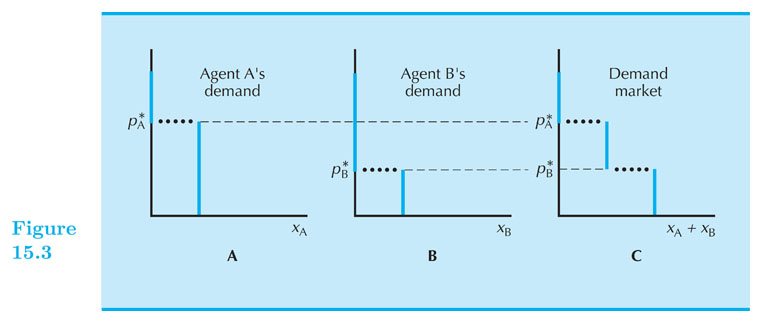Market Demand
Intermediate Microeconomics (Econ 100A)
Kristian López Vargas
UCSC
Market demand
Two goods, $ x_1 $ , $ x_2 $
$ n $ consumers, indexed by $ i $
Individual demands: $ x_{1,i}(p_1, p_2, m_i) $ and $ x_{2,i}(p_1, p_2, m_i) $
$ X_{1}(p_1, p_2, m_1, ..., m_n) = \sum_{i=1}^{n} x_{1,i}(p_1, p_2, m_i) $
$ X_{2}(p_1, p_2, m_1, ..., m_n) = \sum_{i=1}^{n} x_{2,i}(p_1, p_2, m_i) $
Market demand - graphically
Market demand is the horizontal addition of individual demands.
Make sure you properly account for "zero demand" above highest "reservation price".
Market demand - graphically
Market demand - Example - Cobb Douglass
$ u = x_1^a x_2^b $
$ 100 $ consumers, indexed by $ i $
All individual have the same preferences, so same demand functions: $ x_{1,i}^* = \frac{ a }{ (a+b) } \frac{ m_i}{ p_1} $
$ \begin{aligned} X_1(p_1, p_2, m_1, ..., m_{100}) &= \sum_{i=1}^{100} \frac{ a }{ (a+b) } \frac{ m_i }{ p_1 } \\ ~ &= \frac{ a }{ (a+b) } \frac{ \sum_{i=1}^{100} m_i }{ p_1 } \\ ~ &= \frac{ a }{ (a+b) } \frac{ M }{ p_1 } \\ \end{aligned} $
- What if there are different types of consumers?
Market demand - Example - Linear Demands
- Suppose that the market consists of two individuals with demand functions given by:
$ x_{adam}(p, m_a) = max(20-p,0) $
$ x_{bob}(p, m_b) = max(30-3p,0) $
- The aggregate demand function is thereby given by:
$ Q^d(p,m_a,m_b) = x_a(p,m_a)+x_b(p,m_b) $
$ Q^d(p,m_a,m_b) =\begin{cases} 50 - 4p & if ~ p < 10 \\ 20 - p & if ~ 10 \leq p \leq 20 \\ 0 & if ~ p > 20 \\ \end{cases} $
Reservation price
Some goods come in large discrete units
Reservation price is price that just makes a person indifferent
$ u (0 , m) = u(1, m − p^{*}_{a}) $
Add up demand curves to get aggregate demand curve
Market demand - discrete goods

Elasticity
Measures responsiveness of demand to price
$$ \epsilon = \frac{p}{x} \frac{dx}{dp} $$
What does elasticity depend on? In general, how many and how close substitutes a good has.
What does it mean? Why is not just the derivative?
We care about the magnitude so we often use: $ | \epsilon | $ instead of $ \epsilon $
Elasticity - Example for linear demand curve:
We will use q instead of $ x_1 $ or $ x_2 $
Let demand curve be: $ q = a − bp $
Price elasticity of demand: $ ε = −b \frac{p}{q} = \frac{−bp}{a−bp} $
Elasticity - Example for linear demand curve:

Elasticity - Iso-elastic demand curve:
Let demand curve be: $ Q = A p^{-b} $
Lets calculate the elasticity:
$$
\begin{aligned}
\epsilon &= \frac{p}{Q} \frac{dQ}{dp} \\\\
&= \frac{p}{ A p^{-b} } ~ A (-b p^{-b-1} ) \\\\
&= \frac{A}{A} (-b) \frac{p ~ p^{-b-1} }{ p^{-b} } \\\\
&= -b \\\\
\end{aligned}
$$
Elasticity classification
Elastic demand: absolute value of elasticity greater than $ 1 $
Inelastic demand: absolute value of elasticity less than $ 1 $
Revenue
Revenue, price increase and elasticity
Demand curve: $ Q^d = Q(p) $
Revenue: $ R = p \times Q $
When does an increase in price turn into an increase in revenue?
That is, when $ \frac{dR}{dp} > 0 $ ?
Revenue, price increase and elasticity
$$
\begin{aligned}
\frac{dR}{dp} &= \frac{d(p Q(p))}{dp} \\\\
~ &= p \frac{dQ}{dp} + Q(p) \\\\
~ &= Q \big( \frac{p ~ dQ}{Q ~ dp} + 1 \big) \\\\
~ &= Q ( \epsilon + 1 ) \\\\
\end{aligned}
$$
So as long as $ \epsilon > -1 $, we will have that $ \frac{dR}{dp} > 0 $.
Revenue, price increase and elasticity
You can use the same math, to see that if $ \epsilon < -1 $, then $ \frac{dR}{dp} < 0 $.
Why does this matter? Consider the case of the linear demand where elasticity changes from 0 to -infinity as we increase price. Now we know that:
At a price level where demand is price-inelastic (which happens at low prices), an increase in price will increase revenue. And,
At a price level where demand is price-elastic (which happens at high prices), a decrease in price will increase revenue.
In conclusion, the price level that maximises revenue must be when the price-elasticity equals 1. The point we call unit-elasticity price level.